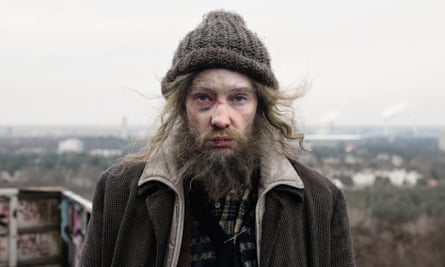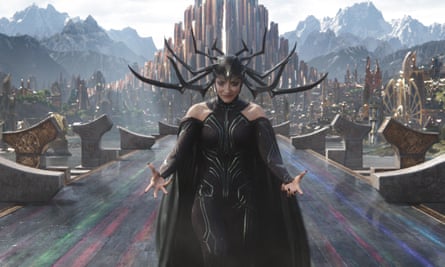Here’s Cate Blanchett as you’ve never seen her before: as a bearded old man pulling a shopping cart through a post-industrial wasteland. In a drunken Scottish accent he/she proclaims: “We glorify the revolution aloud as the only engine of life. We glorify the vibrations of the inventors young and strong. They carry the flaming torch of the revolution!” Now Blanchett is a grieving widow telling a funeral congregation, “to lick the penumbra and float in the big mouth filled with honey and excrement”. Now she’s an American news anchor in the studio, talking to a reporter standing in the rain under an umbrella. The reporter is also Blanchett. “Well Cate, perhaps this could all be dealt with if man was not facing a black hole,” she tells her other self. Now she’s a 1950s mother, clasping her hands in prayer before the Thanksgiving family dinner: “I am for art that comes out of a chimney like black hair and scatters in the sky,” she murmurs, as the children eye the turkey hungrily.
These are not clips from the two-time Oscar-winning actor’s showreel; this is Manifesto, originally a multi-screen gallery installation, now an unclassifiable feature directed by German artist and film-maker Julian Rosefeldt. The script is collaged from more than 50 artists’ manifestos from the past century, and recited by 13 different Blanchetts.
Today, the actor is in another persona – different from any of her characters in the film, or any previous roles. Certainly different from her current turn as a green-screen-chewing, emo-styled goddess of destruction in Thor: Ragnarok. This is Blanchett as artistic collaborator. Sipping tea alongside Rosefeldt in a London hotel suite, discussing big ideas in overlapping sentences, they are an articulate double act.
“Well the first thing is: is it a film?” Blanchett begins.
“She keeps asking that,” says Rosefeldt.

“The amazing thing,” Blanchett continues, “is that there are all these assertions of debasing and debunking and destroying what comes before in order to create this fundamental moment of unique artistic expression, but in performing, you’re struck by the similarities between these manifestos: the rhythmic similarities, the energetic similarities and just the intellectual attack.”
Rosefeldt takes up her point: “There’s a lot of ‘down with this’ and ‘to hell with that’. They definitely want to break with structures. Many of them were written when they were just 20 or 21 years old. We now look at these as texts by world famous artists but at the time, often the artwork wasn’t even there yet. They were just angry young people.”
Blanchett continues: “But you know, what I admire, whether or not there are certain things in the manifestos that I might find personally repugnant, there’s something brave and noble about having the courage to commit to something. I think the artist understands that you have to invest in something, absolutely.”
Blanchett certainly invests here. They shot Manifesto in just 11 days on locations in and around Berlin, which often meant playing being, say, the old Scottish man in the morning and the newsreader in the afternoon, then preparing the next days’ accents in the hotel room in the evening. Even simply learning all her lines was a challenge, she says. They got by with the help of a voiceover, hidden smartphones, earpieces and giant cue cards. Still, there are sizable tracts Blanchett addresses straight to camera. Often they only had time to do one extended take.
She seems to have enjoyed the change of pace: “I always work best – which is why I love theatre – where it’s just: ‘The audience is there. It doesn’t matter whether I feel like doing this or not. I’ve just got to do it.’ It’s got the adrenaline of standup.”
She and Rosefeldt first met in 2010, introduced by a mutual friend at the opening of Rosefeldt’s exhibition in Berlin. The idea for Manifesto formed in 2013, when Rosefeldt was working on Deep Gold, a 20-minute homage to the film-maker Luis Buñuel set, as the explanatory text put it, in “a surrealistic environment rife with bars, brothels, whores, hustlers and naked people strolling around shamelessly”. Not to mention Femen protesters and allusions to the Occupy movement (you could put his video and photography work in a similar bracket to artists such as Matthew Barney and Andreas Gursky). In his researching, Rosefeldt came across two manifestos by French futurist writer and choreographer Valentine de Saint-Point. “I thought: ‘That’s interesting … Manifestos,’” he recalls.
Manifestos have been written by artists across the world and history (although this movie focuses primarily on US and European artists), but the word still evokes the revolutionary spirit of the 19th and early 20th century. Marx and Engels published The Communist Manifesto in 1848 in London, and its “all that is solid melts into air” breaking with the past fed into many subsequent manifestos of early avant-garde, Marxism-influenced art movements.
The textbook example would have to be Filippo Tommaso Marinetti’s incendiary Futurist Manifesto, published in 1909 (excerpts of which Blanchett recites in the film as a ballsy Wall Street trader). Its tenets were nothing if not provocative: “Courage, audacity and revolt will be essential elements of our poetry,” it proclaims. “We will glorify war — the world’s only hygiene — militarism, patriotism, the destructive gesture of freedom-bringers, beautiful ideas worth dying for, and scorn for woman.” (De Saint-Point later wrote a robust response to Marinetti’s misogyny, titled Manifesto of the Futurist Woman).
As an indication of how seriously these writings were once taken, the Futurist Manifesto was published on the front page of French newspaper Le Figaro. “Imagine a British artist published on page one of the Guardian today,” Rosefeldt says, “it would be amazing, wouldn’t it?”
Does art still have the potential to be that revolutionary?
Rosefeldt argues that it does. He cites the recent awarding of the Nobel peace prize to the International Campaign to Abolish Nuclear Weapons. “It’s a utopian idea, but to state it, and to insist on it, and say: ‘That is what we should aim for’ – that has a manifesto character. That’s what all these texts have in common: that they are risking saying something that is almost impossible to realise.”
The film has also begun to resonate in unanticipated ways in places where they have shown it, says Rosefeldt, such as in Istanbul, shortly after the referendum granting President Erdogan sweeping new powers, and in France, after elections in which the Front National was in genuine contention. Meanwhile, in the US, Donald Trump’s fixation on “fake news” gave Manifesto’s newsreader segment a new relevance.

The political landscape has shifted towards populism and against “elitism”, Rosefeldt suggests, which puts topics such as art history in the firing line. “Every populist wants to cut down cultural budgets and educational budgets for a good reason: because they need stupid minds to be manipulated and to become sheep of consumerism.”
Blanchett agrees: “It’s that notion of ‘elitism’, provocative ideas being the domain of the educated, and keeping those ideas separate from the people who they’re trying to keep uneducated and disenfranchised. This is why artists’ voices are being taken away, and the social and political discourse we’re dealing with at the moment is so utterly simplistic.
“As much as Manifesto is about the role of the artist, I think it also asks, ‘What’s the role of the audience?’ Often their attention span is underestimated, and if you’re constantly shooting below the intelligence or the capability of an audience then the work gets thinner and thinner.”
So how does she square that with appearing in Thor: Ragnarok?
She laughs. “Yeah. All things are an experiment, aren’t they? If you know the outcome then why do it really? There’s got to be an element of risk and fun and fuck-up. That’s what keeps me energised: involvement in projects of different scale and ambition.”
Is there a certain dissonance between, let’s say, Manifesto Blanchett and Thor Blanchett?
“Well, I haven’t done that many effects movies, believe it or not,” she insists. “I went in as wide-eyed and bushy tailed to [Thor] as I did into this. And also, it shouldn’t be thus, but I felt like I was speaking to different audiences.”
Perhaps she’s channelling Tristan Tzara’s Dada Manifesto: “I write this manifesto to show that people can perform contrary actions together while taking one fresh gulp of air.”
In Dadaist spirit, then, Manifesto acknowledges and celebrates contradiction, which is another way of saying it has its cake and eats it. It can be appreciated as a representation of challenging ideas and ideals, or as a surreally entertaining one-woman sketch show that might just expose audiences to some provocative ideas, maybe even inspire them to write their own manifesto.
“Whether you agree or disagree with the notion of a manifesto, it’s an effort to engage,” says Blanchett. “It’s an encouragement. It’s about something.”
Rosefeldt concurs: “Something that started as a love declaration to these writings has almost bcome a call for action. You feel like it’s time for action again.”
